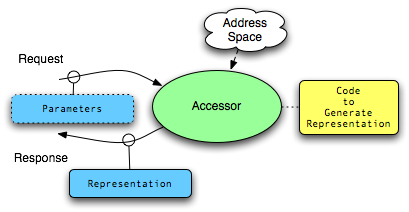We have seen that the fundamental operation in NetKernel is the resource request.
Most application development work
will involve composing systems at the logical level using resources and services.
While working at the logical level is productive and leads to flexible
and fast applications, actual computational work is done beneath at the physical
level.
The following diagram illustrates how an Accessor
sits at the boundary between the logical and physical levels.

When a resource request is sent to NetKernel the URI address is
resolved within an address space to a software endpoint, the accessor.
The accessor is presented with the request and associated parameters.
The accessor then uses whatever physical level data, objects and libraries
it needs to perform its work and then returns a response with a
resource representation.
Accessor code may be written in any supported
language in NetKernel including Java, JavaScript,
Beanshell, Python, Groovy or Ruby.
(When you visit the
Code First introduction you will see Java, Beanshell
and JavaScript examples of accessors)
Even requests for static physical representations using the
ffcpl: scheme are sent to an accessor - in
this case the accessor that implements the ffcpl: scheme.
We have already seen how the active: scheme is
used to activate services and pass parameters in a single
resource request.
Let's take a closer look at how this works at the boundary between
the logical and physical layers.
When a request for the URI
active:xslt+operator@ffcpl:/src/format/style.xsl+operand@ffcpl:/src/book/chapter.xml
is sent to NetKernel it resolves active:xslt
to the xslt service endpoint.
It then sends the request to the physical level code.
The following diagram shows the xslt service being
called with the XML resource to be transformed by the
XSL instructions in another resource.
At the physical level we show that the service relies on the Xerces open-source
library.
Note that the xslt service is stateless - it does not remember
anything between calls.
All that it needs to perform its work is provided when it is called
(This is an example of a RESTful service).
Also note that the operand and operator
arguments are URI addresses - not the resources themselves.
To get these resources, the xslt service must issue
sub-requests for each one and in the responses get the actual
representations.
The xslt service does not need to know any specific details about
how the representations are generated or delivered.
All it does is ask for them in a sub-request and uses the returned
representations when they are available.
This logical coupling at the resource level provides an architecture
that is innately loosely coupled, late bound, and infinitely flexible.
For example, the ffcpl:/src/format/style.xsl resource
could be mapped to:
- A remote resource
- A database query
- A style generating service which uses its own configuration information.
- A static file
And, not only does the xslt service not care how the resources
are provided, the mapping could be changed at any time while the system is
running 24*7.
This flexibility is practically impossible to achieve in a system implemented
using traditional physical code.
In NetKernel, this flexibility is inherent in the system.
Transports
Where do the original requests come from?
While we are looking at the boundary between the logical and the
physical we should briefly explore how requests originate.
In NetKernel a transport acts as an event detector
and bridge from the outside world.
For example, the HTTP transport listens for an HTTP request and when
one is detected, it creates a corresponding request and injects
this as a root request into an address space.
When the response to the root request arrives, the HTTP transport
packages it up into a suitable form and returns it to the external client.
NetKernel provides several transports including HTTP, JMS and Cron.